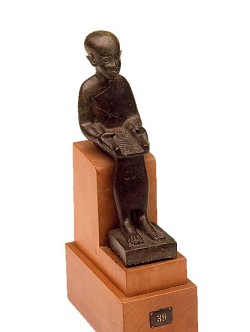
Imhotep is famous above all as a master builder; he was a pioneer in the field of stone construction and the architect of the Step Pyramid. He is one of the best known figures from the Old Kingdom, even though he held no high state position and was not a member of the royal family.
In the New Kingdom, Imhotep became the patron of scribes and the personification of the concept of 'wisdom' as incorporated in the so-called 'wisdom texts'. He was depicted as a seated figure, beardless, with a headdress like Ptah's on his head and an unrolled papyrus on his knees. In the Turin Royal Canon, Imhotep is already referred to as 'the son of Ptah', and this development culminated in full divine status in the 26th Dynasty, complete with temple, priests and a cult. The Imhotep cult was originally popular in the area around Memphis, and during the Ptolemaic Period his temple near the Serapeum attracted many pilgrims. During this period his popularity began to grow in other religious centres in Egypt. Although he appears in many places in temple reliefs, he does not seem to have had any significance for religious life. It was a different story in Thebes - his worship there penetrated many layers of the population. He and Amenhotep, son of Hapu, with whom he is linked, were worshipped as a divine pair and in the Ptah temple in Karnak he functioned through oracles and dreams. He played the role of intermediary and assistant in times of distress due to illness or childlessness.
The inscriptions left by visitors to his cult centres and the remains of domestic altars demonstrate how popular Imhotep was here in circles beyond the temple. Unlike in Memphis or elsewhere, in Thebes Imhotep's divine status completely overwhelmed his historical existence. The end of pharaonic culture did not mean the end of Imhotep's popularity. In the hermetic texts of later date he is still a beloved figure and he continued to be revered as a saint in the Arab tradition until deep into the 19th century.